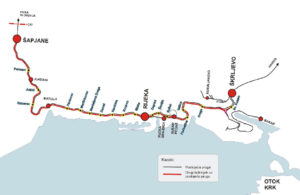 The construction of the second track of the existing railway line and the introduction of the urban /suburban railway line was predicted by master plans dated back to 2003 (namely since the adoption of the Spatial planning master plan of the city of Rijeka).
The construction of the second track of the existing railway line and the introduction of the urban /suburban railway line was predicted by master plans dated back to 2003 (namely since the adoption of the Spatial planning master plan of the city of Rijeka).
This construction fits into future phases of the construction of the Rijeka junction that are connected with the construction of a new lowland line from Zagreb to Rijeka and a new railway line from Rijeka to Istria.
The construction of the second track of the existing railway line Škrljevo – Rijeka – Šapjane includes the reconstruction of the existing terminal stations and railway stations on the mentioned railway line section and the construction of new railway stations for use in urban and suburban transport.
Railway stations outside the city boundaries will be used as endpoints (Jurdani, Škrljevo, together with Matulje, Rukavac and Jušići). Transport organised in this way, has a character of suburban transport. The length of the route within the city boundaries is approximately 18 km.
Along the corridor the following urban/suburban railway stations are being built: Pavlovac, Martinkovac, Marčeljeva Draga, Kantrida/Zamet, Krnjevo, Mlaka, Centar (Kolodvor), Zagrad, Školjić, Sušak, Pećine, Podvežica, Vežica, Draga, Sveti Kuzam.
In accordance with the plans prepared by the Croatian Railways the preparation of complete documentation for this intervention, including proprietary and legal preparation should be completed by 2020.

The Rijeka traffic corridor is an integral part of the Trans-European Transport Network TEN-T (Mediterranean corridor), as well as the railway transport corridor RH2 in the territory of the Republic of Croatia (from the state border via Zagreb to Rijeka and Šapjane and the Slovenian border).
The Rijeka railway junction forms part of that traffic system, the route’s starting point and its destination (road and railway) that connects Croatian hinterland and thus the entire European transport system with the Adriatic.
In view of the development plans and the need to balance the level of road and railway transport service as a system, modernisation and construction of two-track railway lines from Rijeka towards hinterlands has been planed as well as within the Rijeka railway junction.
The Rijeka railway junction has not undergone significant changes over the last hundred years since the construction of railway lines towards ports within the junction. The basis of the railway junction is the railway line section from Škrljevo to Jurdani and all the terminals/ports in this junction and its connecting lines are tied to this section. In view of the planned increase in capacities of the port of Rijeka, that will be realised with the reconstruction of the existing Brajdica container terminal and the construction of the new container terminal on the Zagreb pier, it will be necessary to increase the capacities of the railway, which implies the reconstruction of port tracks alongside the container terminals, the reconstruction of the terminal and the construction of the second railway track from Škrljevo to Rijeka and from Rijeka to Šapjane.
The present wider area of the Rijeka railway junction stretches from the railway station Škrljevo and Bakar, on the east side to Šapjane to the west. The area of the city of Rijeka is somewhat narrower and it stretches from Škrljevo to Opatija.
The railway section from Škrljevo to Šapjane has already become part of the urban landscape and it represents a potential that can be adequately used for fast and efficient passenger transport in the territory of the city and its surroundings (urban and suburban transport). In order to realise this it is necessary to build the second track of the existing railway line. The need for the construction of the second track of the existing railway line from Škrljevo to Šapjane was pointed out as far back as the 80s when a preliminary design of the modernisation and additional construction of the Rijeka railway junction was prepared.

